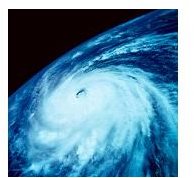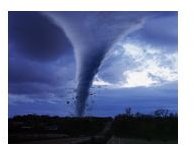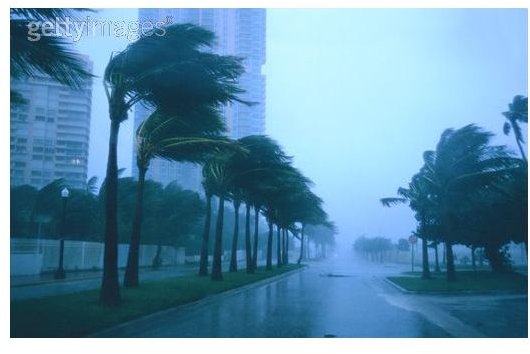Storm Photography - How to Take Pictures of Storms
Digital Photography in Bad Weather
When foul weather hits don’t put your camera away – protect it from the elements, then get out there and shoot bad weather and storm digital images that will set you apart from the pack. Here are some suggestions on how to protect your camera and equipment while braving the elements for storm photography.
Before the newspaper staff photographers headed out of the newsroom into potentially violent weather and dangerous situations, the chief photo editor would always say to us, “Remember that while getting the story in pictures is important, your safety comes first – be careful out there and don’t take any unnecessary chances”. Appropriate words for digital photographers headed into stormy weather in more ways than one.
Storm photography: Capturing the Violent Side of Weather
No matter where you may live on the planet, you are subject to some type of storm or violent weather during the course of each year. Many types of storms are caused by rapid changes in air temperature over an expansive area. The resulting collision between cooler air masses and warm fronts of air, when combined with a high moisture content in the atmosphere (humidity) can result in some of the strongest, most violent forces found in nature. They also provide some of the most highly-neglected photo opportunities of the digital photographer’s world.
Types of Storms and Severe Weather

Hurricanes – When high-velocity winds rotate around a low-pressure area of the storm, know as the “eye”, and these winds of up to 75 mph (F1), or up to 155 mph or more (F5) the storm is referred to as a hurricane. They originate out in the Atlantic, Pacific and Indian Oceans and the Caribbean Sea. Pacific Ocean Hurricanes are often referred to as Typhoons.

Tornadoes – Most common in the central plains areas from Canada to the Gulf of Mexico in the USA and forming in early spring, these violent whirling winds that are funnel-shaped or wedged-shaped, can reach rotation speeds of 300 mph to 500 mph in the most severe, rare (F5) tornadoes. While tornadoes do occur in other parts of the world, more than 80% of the world’s tornadoes are in the United States. There are five categories, from F1 to F5 – the strongest, of this type of storm which when formed over land are called tornadoes or cyclones and when formed over water are referred to as waterspouts. There have been reports of tornadoes on all the earth’s continents with the exception of Antarctica.
Sandstorms – in large, sandy desert areas, strong, wind-driven storms blow sand at high rates of speed capable of “sand-blasting” surfaces with very destructive force. Extreme personal caution must be taken when taking photographs during sand storms as the blowing sand can be extremely abrasive. Best images are usually taken at the front of an approaching storm or to demonstrate its aftermath. Dust storms are similar in nature although far less damaging. Wear a covering over your eyes, nose and mouth to promote visibility and easier breathing in the dust-laden atmosphere. Your equipment could be at risk from dust infiltration too, so take the necessary steps to protect it accordingly.
Hail – When raindrops freeze while falling from the upper atmosphere, they form pellets of ice known as hail. These pellets can be blow upwards to freeze together with others to form larger and larger balls of hard ice which can be potentially lethal to animals, cattle and humans caught in open areas without protection. When shooting images in a hail storm, stay near a protective shelter of some type so if it worsens you can get to safety immediately. Do not point your camera upwards to minimize damage to your face and camera lens by large hailstones. Focus on the hail’s effects and shoot images that indicate the size of the hailstones. If low light conditions prevail, use a wide lens aperture (f5.6) and a mid-range shutter speed (1/125th or 1/250th second) to capture the scenes, property damage and effects of falling hailstones. Minimize any potential danger to yourself by shooting from beneath overhead protection or from indoors.
Thunderstorms and Electrical storms – On many occasions, you can hear thunder caused by the lightning and rapid air temperature changes that accompany electrical and thunderstorms even before the arrival of rain. This compressed-air sound wave, called thunder comes from a lightning bolt suddenly heating the surrounding air to temperatures of 10,000C or 18,000F degrees in a matter of milli-seconds. This sound then travels at a speed of about one second for every five miles. Thunderstorms, lightning and electrical storms can be quite photogenic in nature but dangerous as well. Photographers should be familiar with lightning safety tips for their own protection.
Blizzards – heavy snow storms can bring sub-freezing temperatures, icy conditions and such a high-density of snowfall that everything is blanked-out and appears solid white. Such a condition is known as a “white-out” and can be extremely dangerous. Snowstorms and blizzard-conditions require smaller aperture settings of _f_16, _f_22 or smaller with a medium to high shutter speeds of 1/250th to 1/500th second or faster to allow for photographing contrasts between the extreme “white” bright conditions and darker, visible objects. Both the photographer and camera need to be protected from freezing, humid conditions.
Lightning Safety Tips:
When outdoors near lightning strikes, according to the National Lightning Safety Institute you should:
· Stay away from hills and high ground
· Avoid open spaces and electrical wiring and power transmission facilities
· Stay away from fences, trees and other tall objects
· Stay out of or away from large bodies of water
· Not use wired telephones or electrical appliances, computers, televisions, etc.
· Seek shelter in a large building or an enclosed metal vehicle with the windows closed
· Crouch down with your feet together and your hands covering your ears to help avoid damage from thunder
Storm Photography Shooting Tips:
When shooting images of storms or violent weather of any type, keep these storm photography shooting tips in mind.
· Consider your personal safety as paramount at all times
· Don’t take unnecessary chances during storm photography sessions
· Use foreground objects to frame the image
· Use the “rule of thirds” when possible to compose your images
· Take your storm photography images from a position of shelter or safety when it is practical to do so
· Capture dramatic effects of the storm in addition to the storm’s elements
· Use automatic lens and aperture settings, but bracket those settings both above and below the auto settings to ensure proper exposure of the storm and its elements
· Use a UV filter for better image quality and added lens protection
Remember to be safe, properly protect your equipment, but be creative in your photography of storms and violent weather.
Related Articles
For tips and techniques related to specific storm conditions, please check out the following articles:
